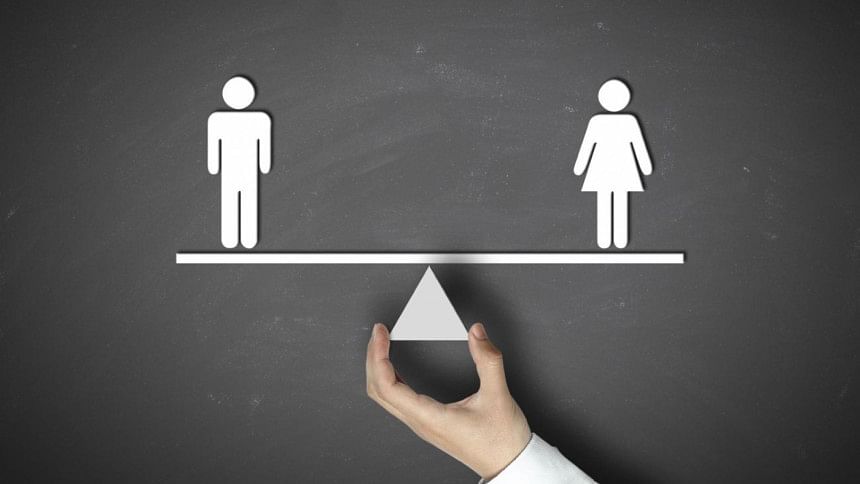Technology can help close the gender gap in Bangladesh

Each morning at 6am, across from the American Embassy in Dhaka, hundreds of day labourers wait in hopes of finding an employer. Garments, domestic, and hospitality workers walk on either side of the street toward factories, homes, and hotels.
In Bangladesh, about 85 percent of jobs are in the informal labour market. These are not only jobs in construction, garments, and domestic work, but also graphic designers, beauticians, IT support, and mobile phone technicians. Their daily wages depend on how effectively they can negotiate salary, learn new skills, and develop relationships with employers.
According to the Bangladesh Labour Force Survey, more than 90 percent of working women are in informal employment; and more than one half of women in the informal economy have little or no education.
Bangladesh has made significant economic strides in the last two decades, but in order to continue its rapid growth, the country must invest in new solutions for one of its fastest-growing workforces: women.
Across the country, women earn about half as much as men; this gender gap is only exacerbated in the informal market where, for example, a male construction worker can make one and a half times more than his female counterpart.
This is both a social concern and an economic one. There are significantly less women in the workforce as compared to men, especially in Bangladesh. Between 2003 and 2010 women's workforce participation barely increased: from about 27.5 percent to 37 percent of women were working as compared to 90 percent of men. This puts Bangladesh below other lower-middle income countries and far lower than the average for middle-income countries (48 percent).
More concerning? The percentage of working women actually decreased by six percent between 2010 and 2016. Research done by the World Bank shows that women have less access to high-quality jobs as compared to their male counterparts. They are unable to access jobs and also struggle to maintain employment when they do. Globally, women's economic equality could add as much as USD 12 trillion to Gross Domestic Product. To foster the economic growth we envision for Bangladesh, we need to ensure that women have equal access to jobs and break down the barriers to employment that stand in their way.
As a manager for BRAC's Skills Development Program, I have seen firsthand how successful job placements can increase employment in the short- and long-term. For the last five years, our programme has secured jobs for 95 percent of our more than 39,000 participants. To drive these results, we train disadvantaged youth, especially women and people with disabilities, through on-the-job apprenticeships. Women leave the programme equipped with skills to repair motorcycles and cell phones, work in hospitality, or graphic design, or in the garment sector. Our evaluations show 77 percent of our 2014 graduates are still employed and their income increased six times.
But despite training women to competitively enter the workforce, there are still significant barriers that can compromise their productivity and wage equity. Initial research shows female participants dropping out of the market at a higher rate than their male counterparts, which is cause for concern. Many female graduates of BRAC's skills programme report difficulty navigating the job market and employers on their own. Where should she go to find a new job? How might she improve her skills? How can she grow in her current job or move into a higher position? How does she address discrimination or violence in an unregulated workplace?
There are remarkable opportunities for new technology to address these systemic issues. A platform designed for working women could create an inclusive marketplace, with resources for her to develop her skills and access jobs. A recent article in Fast Company highlights the role technology can play in creating an online community and support network that empowers women workers and addresses harassment. Other sites like Glassdoor provide workers with transparent information about how much their peers are making across industries. Platforms like these, specifically for Bangladeshi women in the informal market, could foster mentorship, provide ongoing training, and improve salary negotiations—giving women the insight and tools they need to get ahead. It could also illustrate to employers the incentives for hiring women whose skills are on par with their male counterparts.
Technology products specifically designed for women have had marked success and offer a counterpoint to those that market to women as an afterthought. Companies like Ellevest, an investment company that offers advice for women, have had profound success with this approach. Ellevest advises women on their investments, keeping in mind their unique financial situation: compared to men, they live longer, take more career breaks because of children, and make different investment decisions. Services targeted at women, especially those provided digitally, must be created with a woman's life, habits, and lifestyle in mind if they are going to be effective and adopted widely.
There are also significant opportunities for employers—from small firms to large enterprises—to leverage technology to close the gender pay gap, ensure transparency for shareholders, while also fostering high productivity to deliver on their bottom line. In Mozambique, the mobile platform Biscate is helping companies hire workers who have been vetted and rated based on their previous work experience. Companies can also advertise services, products, or job openings to workers while also assessing industry trends. There are more than 1,000 female workers on the platform who can access the same job opportunities as men. Putting systems like these can both positively impact employees while also increasing profits with more efficient and effective hiring processes.
We have the opportunity, and challenge, of using technology, coupled with effective programmes and adoption by employers, to close the gender gap in the workforce. It is not just socially responsible for us to prioritise a solution that works; but Bangladesh's future, both socially and economically, depends on it.
Eshrat Waris is the manager of the Skills Development Programme at BRAC.










Comments